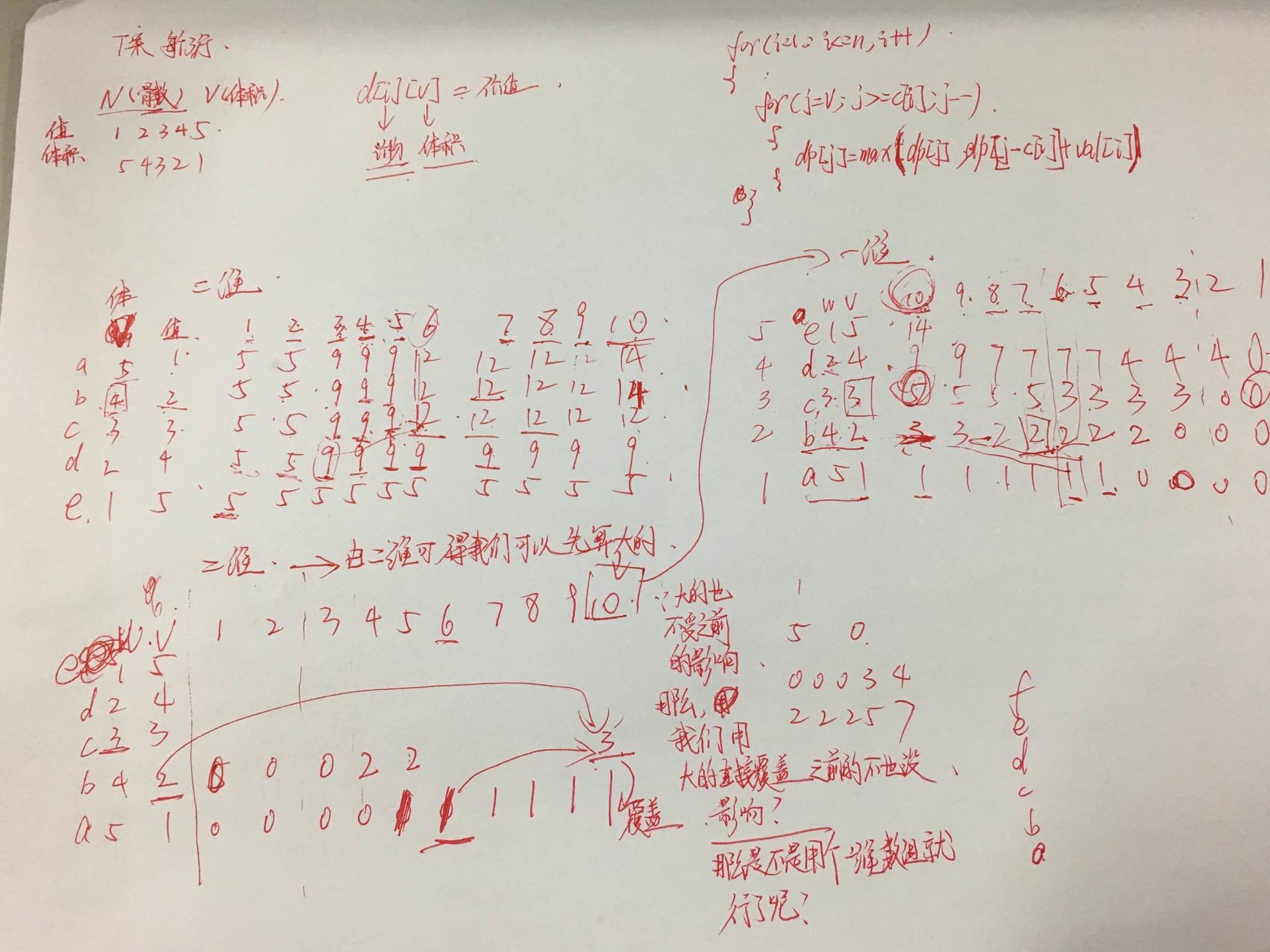Bone Collector
Time Limit: 2000/1000 MS (Java/Others) Memory Limit: 32768/32768 K (Java/Others)
Total Submission(s): 65099 Accepted Submission(s): 27122
The bone collector had a big bag with a volume of V ,and along his trip of collecting there are a lot of bones , obviously , different bone has different value and different volume, now given the each bone’s value along his trip , can you calculate out the maximum of the total value the bone collector can get ?

Followed by T cases , each case three lines , the first line contain two integer N , V, (N <= 1000 , V <= 1000 )representing the number of bones and the volume of his bag. And the second line contain N integers representing the value of each bone. The third line contain N integers representing the volume of each bone.
#include <iostream> #include<math.h> #include <iomanip> #include<cstdio> #include<string> #include<map> #include<vector> #include<list> #include<algorithm> #include<stdlib.h> #include<iterator> #include<sstream> #include<string.h> #include<stdio.h> using namespace std; int dp[1001][1001]; int max(int x,int y) { return x>y?x:y; } int main() { int t; cin>>t; int n,v; int vol[1001],value[1001]; while(t--) { cin>>n>>v;//记录骨头数量和总体积 for(int iii=1;iii<=n;iii++) { cin>>value[iii];//记录值 } for(int ii=1;ii<=n;ii++) { cin>>vol[ii];//记录体积 } memset(dp,0,sizeof(dp));//把背包初始化为所有的情况价值都为0 for(int i=1;i<=n;i++)//有几件物品 { for(int j=0;j<=v;j++)//表示有几件物品时,你的背包容量在变化的同时,你背包的总价值是否发生了变化 { if(vol[i]<=j)//当你的背包放得下第i件物品时 {//就要考虑两种情况 1.放这件物品,也就是为这件物品腾出空间,然后计算剩下的空间放I-1件物品的最大值,这时候背包的价值=dp[i-1][j-vol[i]]+valu[i] //2.不放这件物品,就是只考虑在这样的容量下,放i-1件物品的情况。这时候 背包的价值为: dp[i-1][j] //所以我们就要比较他们的最大值 dp[i][j]=max(dp[i-1][j],dp[i-1][j-vol[i]]+value[i]); } else{//当放不下这件物品的时候(要是只有一个公式的话 ij 可能会负) dp[i][j]=dp[i-1][j]; } } } cout<<dp[n][v]<<endl; } return 0; }
然后在此进行一位数组的解释,这边有一个讲的还是比较清楚的:http://blog.csdn.net/qq_32036091/article/details/51301912
且说小Ho搞清楚了计算方法,正在埋头苦写代码,在一旁看他写代码的小Hi是在看不下去了,决定再指点指点小Ho:“小Ho啊!”
“怎么了?”小Ho眼睛盯着屏幕,望都没望小Hi一眼。
“你现在是不是需要开一个N * M大小的二维数组best,来记录求解出的best值呀?”
小Ho终于有了点反应,抬起头来说道:“是啊,怎么了?“
“我有办法不用开这么大空间哦~”小Hi笑嘻嘻道:”可我就是不告诉你!”
“诶,别这样,我请你吃雪糕!”小Ho一听就急了,连忙许下了报酬。
“开玩笑啦~”小Hi也是随便逗了逗乐子就没继续:“你想想,在i已经是10以上的时候,best(5, j)这样的值还有用么?”
“没有用了……你是说,我并不需要在内存中存下来所有的best(i, j),没有用了的值都可以不进行保存……也就是说,实际上只要开一个2*M大小的数组就可以了,然后像这样的方式进行来回的计算,是不是就可以了?”

“是的呢!但是还可以更少哦~让我来写这个程序的话,我只需要开一个M大小的一维数组就可以了”小Hi自信的说道:“你想想,如果我按照j从M到1的顺序,也就是跟之前相反的顺序来进行计算的话。另外根据我们的状态转移方程,可以显然得出如果状态(iA, jA)依赖于状态(iB, jB),那么肯定有iA = iB+1, jA>=jB。所以不难得出一个结论:我在计算best(i, j)的时候,因为best(i, j+1..M)这些状态已经被计算过了,所以意味着best(i - 1, k),k=j..M这些值都没有用了——所有依赖于他们的值都已经计算完了。于是它们原有的存储空间都可以用来存储别的东西,所以我不仿直接就将best(i, j)的值存在best(i-1, j)原有的位置上,就像这样。”

“原来还可以这样!这样一处理,不仅空间复杂度小了很多,代码也很好看了呢!”小Ho开心道。
“那你还不去写?”
然后,我在这边附一张自己的演示图:

然后,根据你在纸上换算的过程,你可以得到一个核心算法:dp[j]=max(dp[j],dp[j-vol[i]]+value[i]);
其实一维数组的核心就在于:1.从大到小进行计算 2.对之前的数据进行覆盖。
然后附上代码:
#include <iostream> #include<math.h> #include <iomanip> #include<cstdio> #include<string> #include<map> #include<vector> #include<list> #include<algorithm> #include<stdlib.h> #include<iterator> #include<sstream> #include<string.h> #include<stdio.h> using namespace std; int max(int x,int y) { return x>y?x:y; } int main() { int t; cin>>t; int n,v; int vol[1005],value[1005], dp[1005];; while(t--) { cin>>n>>v;//记录骨头数量和总体积 for(int iii=1;iii<=n;iii++) { cin>>value[iii];//记录值 } for(int ii=1;ii<=n;ii++) { cin>>vol[ii];//记录体积 } memset(dp,0,sizeof(dp));//把背包初始化为所有的情况价值都为0 for(int i=1;i<=n;i++) { for(int j=v;j>=vol[i];j--) {//因为根据状态方程的那个表,我们倒着来算依然没有问题 //而且,倒着算的话,因为我们是先算大的dp[i][j],那么后面小dp[i][j-m]的不会用到之前的dp[i-1][j] //所以我们可以用dp[i][j]直接覆盖掉之前的dp[i-1][j],那么只用一维数组即可 dp[j]=max(dp[j],dp[j-vol[i]]+value[i]); } } cout<<dp[v]<<endl; } return 0; }


